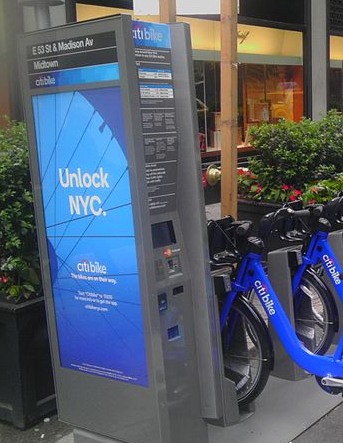New York is a world unto itself. The lifestyle there is unlike that in any other city in the world. People either love New York of they hate it; there’s rarely anyone in-between.
This became even more apparent yesterday when I was perusing the pages of The New York Times website. I spotted an article which caused me to snap to attention. It was entitled: “The Many Uses of the New Hitching Post: Bike-Sharing Docks Also Serve as Gyms or Trash Cans”
Without seeing the accompanying photo (which I cannot share here since I don’t have permission to use it. See it here.), it would be difficult to discern the meaning of this article. By the term “hitching post” the author was referring to the Citibike bike-share stations.
For those who are unfamiliar with the Wild West, the term hitching post originated around 1835–1845, and it referred to a post where a horse or mule could be tied to keep it from wandering away. It has little to do with bicycles unless one wants to draw an analogy between a metal steed and a living, breathing steed. And how humorously this article’s author did just that.
He observed how New Yorkers who did not wish to rent a bike for transportation, had devised other uses for the stations where the bicycles are docked until someone rents them. He sees this as an illustration of “a well-worn maxim of urban planning: If you build something, New Yorkers will find a way to lean on it.”
Yes, for some reason, people in New York sit and lean on everything. They also use stationary objects, which do not belong to them, for purposes other than what they were designed for.
Among the bike station uses the author listed were: shoe tying, chairs, exercise equipment to be used as dip bars for upper body toning, exercise bikes for a cardiovascular workout and a changing room. Believe it or not, a guy was spotted putting his gym bag on the docks and changing his shirt there.
In some areas, the stations have become a playground for local children. Kids come in groups to play on the bikes, mostly using them as stationary bicycles. The bells on the bikes seem especially attractive to the kids; ringing them is seen as a pastime, one which they delight in until an annoyed adult or police officer forces them to stop.
As strange as these behaviors may seem to more civilized urban dwellers, they are, for the most part, harmless. Yet other New York citizen behaviors are not so harmless.
Trash, mainly in the form of discarded food, and no doubt, food wrappers, have been deposited all over the stations. Some areas are probably worse than others, and as the author pointed out, New Yorkers have the gall to leave trash on the hoods of strangers’ cars. Apparently, to them, everything in sight is a garbage can.
On a positive note, the bike stations appear to have become a place where like-minded individuals can meet, make friends, and even flirt. Romantic encounters have been witnessed at the stations. Maybe it’s something like love at first bike-share.
At least there is no mention of vandalism. In New York, vandalism is a national pastime; it will be a miracle if the bike stations are spared.
A number of other U.S cities, including Boston, have bike-share programs. In Boston, and two other cities I’ve visited, where bike-sharing is in place, I have never seen anyone behave the way the New Yorkers in this article are described.
In most cities where bike-shares have been implemented, only those who are renting bikes use the stations. Everyone else just walks past them, without a second thought.
The reaction New Yorkers have had to the stations could mean one of two things: either they have adopted the stations as part of their urban culture and will use them as they use everything else in New York or they will abuse the stations out of disrespect because they don’t want them there.
For the sake of the city, with its horrendous congestion, I hope that the former is true. A bike-share can become part of New York’s culture. The bright blue bikes and the sturdy docks can blend into the landscape. But, if too many people sit on, exercise on, and play on the stations, they will fall into disrepair.
A little police enforcement may be in order for the safety of the bike renters. Allowing children to play on the bikes could lead to mechanical problems. It will certainly increase the maintenance costs of running the program.
Once the novelty of this new program has worn off, these alternate bike-share station uses may die down. Other than possibly sitting on the docks to rest one’s feet, there is no legitimate reason to go near them.
It will be interesting to see how the bike-share idea plays out in a place like New York. Cyclists are in the minority there, and I would imagine that the program’s success will hinge upon the adoption of this form of transportation by non-cyclists who just want a quick way to get from point A to point B.
I eagerly await additional news on how Citibike is faring. After all, New York is home to a unique type of craziness which can make it a difficult place to live, but a humorous place to observe, and a fun place to visit.




